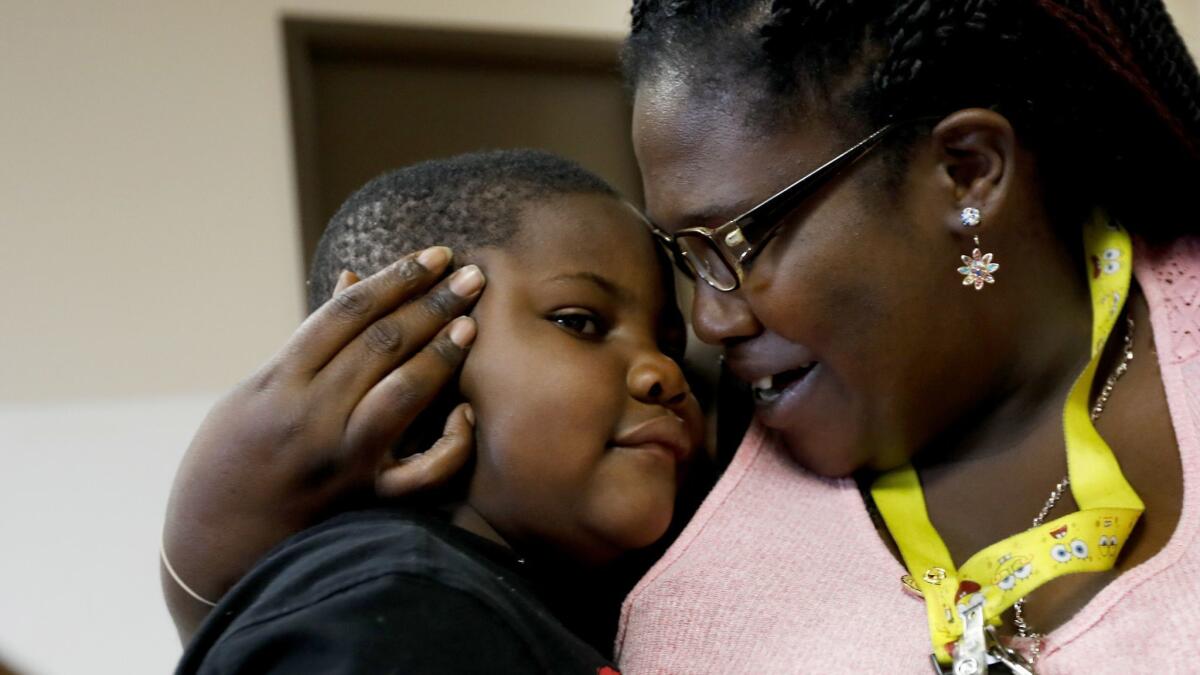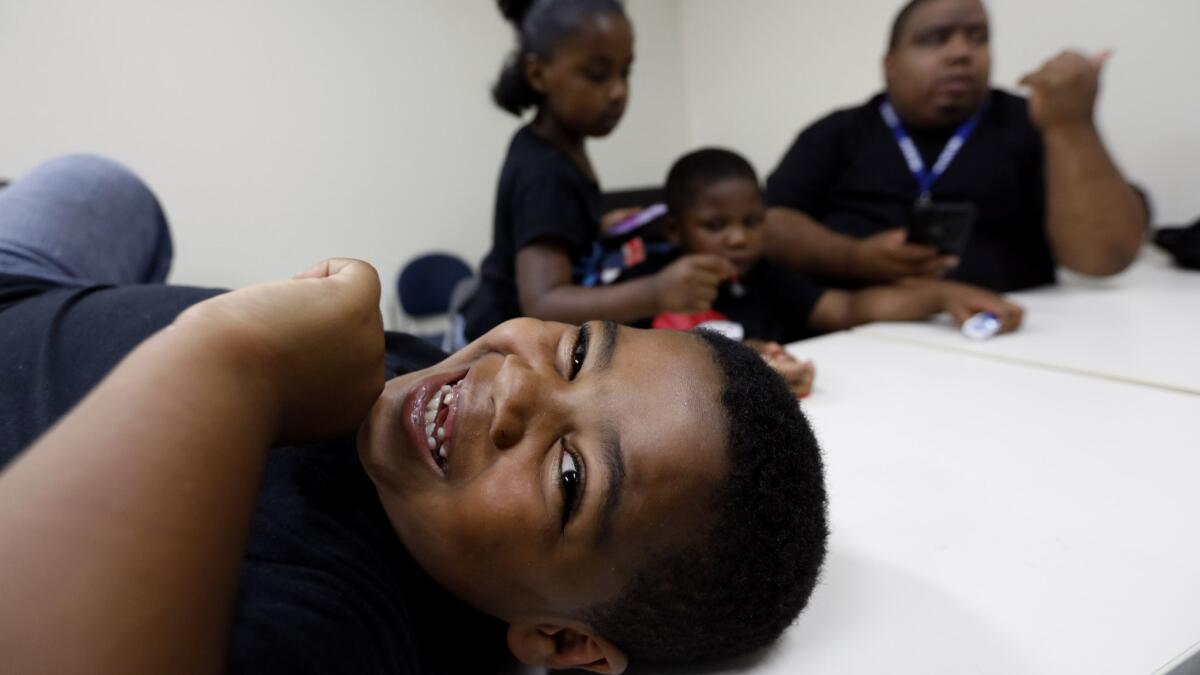Column: Hard times, through the eyes of three children who dream of better days

- Share via
The upheaval in the lives of the Johnson children began a few years ago, when their parents no longer could afford the cost of a Los Angeles apartment despite one and sometimes two jobs between them.
The first move was to Granny’s South Los Angeles home, which worked out fine for a while. But a major plumbing disaster and the damage it caused put them back on the move, this time to an uncle’s house. That was just a temporary setup, though, before they made a decision they had hoped to avoid.
Last September, Alyna, D’Andre and James Johnson — now 8, 6 and 4 — moved into the Union Rescue Mission on skid row with their parents.
“I was scared,” said Alyna, recalling her first impression of a neighborhood where people loitered on streets, sprawled on the pavement and lived in tents. “And I was nervous. Everybody that was outside was, like, creepy, and I was scared about staying there.”
This is all playing out just a few blocks from the downtown construction boom of luxury towers reaching of the sky. The California economy is strong, unemployment is down and many homeowners have equity wealth they never could have imagined. But at this street level, others are drowning, and the cost of survival always seems just out of reach.
Roughly 1 in 5 California children — about 2 million total — live in poverty when the state’s high cost of housing is part of the equation. Many of them suffer through frequent moves, have obesity and other health problems, are forced to change schools and often fall behind.
That’s what the statistics say, but the reports on child poverty are dry, bloodless documents, and all the easier to dismiss because of it. They cannot capture the look in the eyes of a child wise beyond her years — a child who longs for a place to call her own and wishes she could return to the school where she had so many friends and loved her teacher.
That was one of the hardest things about the move to skid row, said Alyna.
“Now I go to Ninth Street School,” she said, the injustice still burning in her dark eyes.
When her family first arrived at the rescue mission, Alyna said, she had to get used to the lack of privacy. They shared space on the floor of a large room with dozens other families for a while, before getting their own one-room unit, with two sets of bunk beds.
And the families keep coming in behind them, through the front door and up the elevator and into the company of broken hearts.
“We hit an all-time record here last night,” the Rev. Andy Bales, CEO of the Union Rescue Mission, said one day last week. “We had a total of 221 children. The fourth floor is full of families, the fifth floor is full now and we have families spilling into the gym.”
Many people work hard to avoid the homeless. These volunteers embrace them »

Dozens more children live with their mothers at the mission’s Hope Gardens Family Center in the northern San Fernando Valley — a facility that was opened 12 years ago in part so that children would not be exposed to the harsh conditions on skid row.
A few dozen air mattresses lined the walls of the Union Rescue Mission gymnasium last week. When night falls, the mattresses are dropped to the floor and families — often strangers to each other — sleep side by side.
“People’s rents are being raised $300 a month or more, and our own employees are needing our help because their landlords are converting apartments to condos to take advantage of the skyrocketing real estate prices,” Bales said.
“The kids know they’re at the last resort when they come here, and things are very iffy and their moms are trying to put on a face that tells the kids this is temporary, we’ll get out of this. And the kids are thinking, ‘Mom, what’s going to happen? What have you gotten us into?’ ”
Alyna’s brothers have the luxury of being a bit too young to fully comprehend the predicament their family is in. But her experience is a little different.
“She’s very headstrong, smart, and aware of her surroundings,” Alyna’s mother, Geneva Gwin, told me.
The parents try to avoid walking through skid row with their kids. But when it’s unavoidable, Alyna is on full alert, big sister looking after her little brothers.
“We’ll be walking down the street, and she’ll say, ‘Fall back, D.J.,’ ” to her 6-year-old brother if he gets too far ahead of the pack, Gwin said.
Gwin said there were times in her own childhood when her family moved a lot, and they sometimes slept in garages and patios. D’Andre Johnson, her husband, became a foster child as a boy and later was adopted. They survived their circumstances, fell in love soon after meeting each other and got married a decade ago.
“I love my kids,” Gwin said. “But if I could go back 10 years, I would have gone to college, then tried to make money to where I was stable and then start a family after that.”
She worked as a security guard for several years and is now a clerk assistant for a Los Angeles County agency. Her husband is a cook for the Inglewood school district but gets little work in the summer.
Her $13 an hour and his $15 an hour, combined, don’t add up to a place of their own in a state where wages haven’t kept up with the rising cost of living. So right now, they said, they are putting money away for future housing. But so far, nothing affordable has surfaced.
“I feel stuck, like I’m never going to get my family to where they need to be,” Gwin said, wiping away tears as we spoke near her office during her lunch break.
Gwin told me it broke her heart to have to pull Alyna out of her school in South L.A., but the long-distance bus rides to school from skid row and back again in the evening were exhausting.
In the middle of our conversation, Gwin mentioned her other daughter, then paused to gather herself when I asked where she lives.
“She died,” Gwin said, breaking down again. It was sudden infant death syndrome, less than two months after her birth.
A year later, Alyna was born.
“That’s why I want to do everything in my power to make sure my babies are all right,” she said.

Gwin recalled staying up all night on their first evening at the mission, afraid for her children and herself, but not wanting to let her kids know that. She’s grateful for what the mission has done for them, but eager to move on.
“I don’t want my babies to have another birthday at the mission. They want a yard, they want a treehouse, they want bikes and stuff. They wanna go outside and play, and they can’t. … We’re not on drugs, we don’t drink, we have no bad habits. The only thing stopping us from being where we want to be is we don’t have enough money.”
Johnson told me he was once a cook at the mission where he is now a client.
“We messed up, we failed, we came up short,” he said. “The first couple of weeks we were here, I cried every night. My wife is 10 times stronger than me. She said, ‘Babe, we got each other, we’re here, and just be happy we’ve got somewhere to stay.’ ”
He tells himself to stay focused on the day they move out, to be patient and to make sure that no matter what happens, the kids know they are loved.
When I met with the kids, D’Andre Jr. and James were playing with little race cars while Alyna talked about what she sees in her future.
“I want to have a good life,” she said.
She will live in a house that is purple and pink, and she will have her own room and paint it the same colors.
“I’m going to be a good person, and I want to become president. If I was president, I’d lower the prices for everything because they’re not fair to the homeless.”
Get more of Steve Lopez’s work and follow him on Twitter @LATstevelopez
More to Read
Sign up for Essential California
The most important California stories and recommendations in your inbox every morning.
You may occasionally receive promotional content from the Los Angeles Times.











